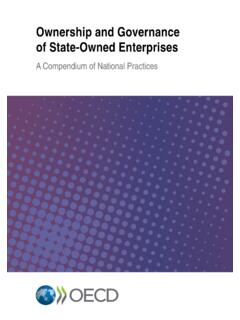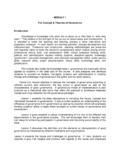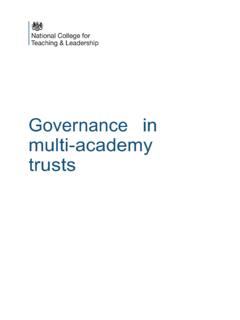Transcription of Getting Infrastructure Right - OECD
1 1 Getting Infrastructure RightThe Ten Key governance Challenges and Policy OptionsTHE OECD FRAMEWORK FOR THE governance OF INFRASTRUCTURE1 OECD. Getting Infrastructure Right : The 10 Key governance Challenges and Policy OptionsHigh-quality public Infrastructure supports growth, improves well-being and generates jobs. Yet, Infrastructure investment is complex, and Getting from conception to construction and operation is a long road fraught with obstacles and pitfalls. Poor governance is a major reason why Infrastructure projects often fail to meet their timeframe, budget, and service delivery objectives. Regardless of how public Infrastructure services are delivered, an OECD survey* of the state of Infrastructure policymaking highlights a number of challenges that all countries face. governance challenges are diverse and occur all through the policy cycle.
2 Designing a strategic vision is crucial but difficult. Many countries have no integrated strategy but instead rely on sectoral plans. Infrastructure projects are vulnerable to corruption, capture and mismanagement throughout the Infrastructure cycle; most countries have recognised this, yet integrity instruments often leave gaps. Political dynamics may undermine sound decision-making with regards to Infrastructure when processes for identifying priority projects and choosing delivery modes are not sufficiently formalised. Without well-managed consultation good projects may falter. Consultation is common in the preparation phase but less common in setting an overall vision or prioritising investments or assessing needs. Coordination across levels of government is difficult despite the fact that a majority of public investment is made at the subnational level.
3 This increases the risk of wasted resources and poor integration of services. Uncertainty with regards to revenue flows and sources can erode confidence in a project s affordability. Unstable regulatory frameworks can prevent long-term decisions. Regulators play a key role in ensuring that projects are attractive for investors, yet they play only a limited role in guiding policy formulation. A lack of systematic data collection on performance undermines evidence-based decision-making and disclosure of key information. Central Infrastructure units tend to focus on delivering the asset, while auditors are not usually tasked with following performance. Lack of disclosure of data on contracts and subsequent operation tends to reinforce concerns about fraud and lack of is mainly a governance *A survey of 25 OECD countries2 Challenge 1.
4 Develop a strategic vision for infrastructureEstablish a national long-term strategic vision that addresses Infrastructure service needs. Ideally the strategy should provide guidance on how the needs should be met, although there has to be room for adjustment as more information is gathered. The strategy should be politically sanctioned, co-ordinated across levels of government, take stakeholder views into account and be based on clear assumptions. Why is this important?A necessary condition for a successful Infrastructure programme is appropriate strategic planning. This requires identifying which investments should be undertaken, determining the essential components, needs and trade-offs, and how they should be prioritised. Conversely, weak or insufficient planning often impedes their successful implementation and operation later in the project cycle.
5 The reason why designing a clear and coherent strategic vision is difficult stems essentially from the complex nature of Infrastructure investment. The Infrastructure issue cuts across different institutions, jurisdictions, levels of government, policy areas and professional disciplines, which makes it difficult to aggregate into a coherent view. Analysis tends to be done in silos reflecting the various stakeholders. Infrastructure development serves multiple objectives, with multiple policy goals such as growth, productivity, affordability, inclusive development and environmental objectives potentially being in opposition. Infrastructure has long-term impact and gestation periods, and requires predictability and sober analysis, but Infrastructure is extremely sensitive to political and economic/business cycles that vary markedly over time.
6 Good Infrastructure planning requires identification of necessary complementarities across sectors. For example, investments in housing need to be complemented by the Right investment in transport networks (OECD, 2014).Key policy questions: Is there a whole of government vision for Infrastructure investment in the medium to long term? Is there an established process for generating, monitoring and adjusting a national strategic Infrastructure vision? Is there a dedicated unit or institution responsible for monitoring, generating, assessing, costing and creating debate around Infrastructure policy? Are there appropriate tools and processes that link the allocation of public resources to the strategic Infrastructure vision?Benchmark indicators: Presence of a strategic Infrastructure plan; Strategic frameworks for public investment implementation; Budget allocation to projects in plan; Dedicated process/units; Presence of inter-departmental/ministerial committees/platforms to design Infrastructure ChangeSocial ImbalancesDepreciation of the country's capital stockInnovation policyDemographyFiscal pressureTransition to a low carbon energy systemRegional development imbalancesTransport bottlenecks151210101097764 Figure 1.
7 What are the key drivers of current strategic plans of OECD countries? (Number of respondents)Total Respondents: 25 Source: OECD (2016), OECD Survey of Infrastructure governance 3 OECD. Getting Infrastructure Right : The 10 Key governance Challenges and Policy OptionsChallenge 2. Manage threats to integrityCorruption entry points should be mapped at each stage of the public Infrastructure project, and integrity and anti-corruption mechanisms should be enhanced. A whole of government approach is essential to effectively address related integrity risks. Why is this important?Corruption allegations often surround government-led Infrastructure projects. The extent of public officials discretion on the investment decision, the scale and complexity of the projects, as well as the multiplicity of stages and stakeholders involved, make Infrastructure projects highly vulnerable to corruption.
8 The Construction Sector Transparency Initiative (CoST) estimates that 10-30% of the investment in a publicly funded construction project may be lost through mismanagement and corruption (CoST, 2012). Within the European Union, corruption costs are estimated to EUR 120 billion per year (European Commission, 2014). The OECD Foreign Bribery Report (2014) also suggests that nearly 60% of foreign bribery cases occurred in 4 sectors highly related to Infrastructure : extractive (19%), construction (15%), transport and storage (15%) and information and communication (10%).Fairness, fiscal prudence and cost-effectiveness may be undermined when politicians favour Infrastructure that disproportionately benefits their donors or core electoral base to the detriment of the society as a whole. A whole of government approach is essential to effectively address related integrity risks.
9 Corruption can occur at every step of an Infrastructure project, including the selection, tendering and implementation phases; and it can involve elected and non-elected public officials, lobbyists, civil society organisations, trade unions, regulators, contractors, engineers and suppliers. The OECD Integrity Framework for Public Investment (2016) proposes a set of specifically tailored measures seeking to safeguard integrity at each phase of Infrastructure Extractive15% Construction15% Transportation and storage10% Information and communication8% Manufacturing8% Human health6% Electricity and gas5% Public administration and defence4% Agriculture, forestry and shing4% Wholesale and retail trade3% Water supply1% Activities of extraterritorial organisations1% Financial and insurance activities1% Other service activities59%Figure 2.
10 Nearly 60% of foreign bribery cases occurred in just four sectorsSectors are identified with reference to the United Nations International Standard Industrial Classification of All Economic Activities (UN ISIC), ( ).Source: OECD analysis of foreign bribery cases concluded between 15/02/2000 and 01/06/20144 Key policy questions Are there measures to: Prevent public officials and private sector employees from accepting or demanding bribes? Adequately identify and manage potential and apparent conflict-of-interest situations? Regulate and limit the use of confidential information by public officials? Prevent the selection of public investment from favouring a particular interest group/individual over the public interest? Ensure the objectivity and credibility of social, economic and environmental feasibility studies?













